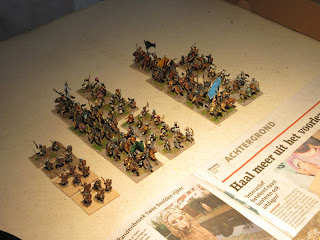The Task
Several years ago, the
Dark Age project was expanded to include a number of Muslim armies, Fatamid,
Bagdad Buyid, North African to name a few. In my enthusiasm I painted ten in
quick tempo and looking back at recent photos decided to re-do them with a bit more
care.
As we play more double
size commands, I decided to consolidate the Muslim collection as the principle
enemies of the Nikephorian Byzantine, the Fatamid, Dynastic Bedouin and the
Iqshidid Egyptian.
Clothing would be given a
dark base colour and highlighted in a lighter shade, dark blue – light blue,
dark green – light green and so on. The turbans, painted with a bit more care,
have more folds, the clothing colours have better eye appeal as do the archers.
Colour schemes and banners set apart the three main adversaries and this is
explained below.
The Fatamid
Clothing - All turbans have a colour which is also found as a
topcoat for another miniature and these are red, blue, and two shades of brown.
The same colour selection is used for the shields with a few painted with a
horizontal bar painted in an off white or cream.
Banners – From D. Nicolle’s Medieval Warfare Source Book,
volume II, the Fatamid had green and yellow flags in a variety of size and
shapes. Further searching I found it was not uncommon to have quotations from
the Koran painted on the banner. Inscription will be done in gold or white.
Second on the list are the
Dynastic Bedouin, specifically, the Emirate of Aleppo. These took less time to
paint and were a joy to do.
The Dynastic Bedouin
Clothing – These differed somewhat from the Fatamid; turbans
would be mostly white with a few tan coloured in between, Topcoats had fewer
brown, but more red, blue and purple. I reasoned the brighter colours would be
prevalent among the settled inhabitants. This also can be seen among the shield
colours.
Banners – These would be of similar size and shape but basic
colour would be an off-white or cream. A dark vertical bar would have text
painted is silver or white. Kurdish allies would have similar flags, but
painted red.
Useful Sources
Armies of the Dark Ages
600 – 1066, Ian Heath, 1980
Medieval Warfare Source
Book, David Nicolle, 1986
Saracenic Heraldry, Leo
Aryeh Mayer, 1933
The Tulunid/Iqshidid
Egyptian (29-03-2020)
The Tulunid/Iqshidid are
next in the queue. Photo one is an overview of the elements collected for this
army. All the infantry will be rebased to improve the distribution of poses
among the blade and bow. Infantry on the left of the photo will have their
javelins replaced with spears. At their rear are two elements of cavalry which will
form three light horse leaving the Ghulam cavalry the only elements untouched.
Photo two displays the
ravages of bases lost with the figures now repositioned on their new bases.
Next step is to replace javelin with spear.
Clothing – Having rebelled against the Abbasid Caliphate, I had
doubts about using black for their clothing and as a minor concession, the turbans
would be painted mostly dark colours with a few in white. Topcoats would follow
a similar palette as the Fatamid, red, blue and two shades of brown.
Banners – Most likely banners would have remained unchanged
from the Abbasid model and colour. Therefore, banners are black with some
colour sections and/or tails with gold lettering. If not accurate at least they
would look cool.
The Egyptians in
battle array
Compare the older paint
work in this old battle report between the Tulunid Egyptian and the Abbasid.
The Abbasid (07-04-2020)
These complete the refurbishing project. I have lost count of all the turbans I
have painted, but the experience was well worth the time. The early figures used as Zanj
found their way to one of the three armies and new ones
were needed as both ‘a’ and ‘b’ sublist of the Abbasid require them.
The new Zanj
blade are Fuzzy Wuzzy from the Old Glory colonial range. Hair was
cut down and filed as were their shields. With small amounts of Milliput I attempted to fashion skull caps which did not work well, but other head gear did and some have dreadlocks. I am pleased with the result and also for
the fact that this took one week to complete.
Clothing – Turbans remained black, but topcoats are
painted in various shades of red from their original black. The colour may not have been historical but
they would look very smart. The same colour scheme was used for the mercenaries and
skirmishing troops as well. Mounted units had very little clothing to see as they were covered in chainmail, vambraces and metal leg protection.
Banners – New flags were made. These remained black, but I added an additional colour to give an accent to the banner. Those for the infantry are a standard shape and large triangular banners were made for the Ghulam cavalry.
Latest additions 30-09-2021
Nine elements representing
the city militias and freebooters have been added to the collection. The
figures are a mix of Old Glory Arab and Sudanese Ansar from their colonial
range plus a few Essex. The ‘solid’ horde are now on larger bases, 40mm x 40mm,
with an additional number of figures. This greatly improves their appearance
and some armies, such as the Syrian IV/6c, have both types.












